Understanding Low and High Helix Angles
The Helix angle of any end mill refers to the angle that is formed between the edge of the tool’s rake face and its centerline. Generally, helix angle of any operation may vary from material to material. The end-goal and finishing may also determine what helix angle is appropriate. Choosing the right helix angle can be the difference between an average, very good or excellent job. How then do you know what is best for your CNC machining project?
Understanding your project needs
When selecting a tool for any machining operation, the material to be worked is a familiar consideration. Tool dimensioning, flute count and surface finish are also common factors, however, the cutting tool’s helix angle is often overlooked.
Helix tools may be broadly classified around the 40-degree mark; there are tools with angles lesser than 40 degrees and those with angles greater than 40 degrees. Tools with <40o helix are more ideal for roughing applications; this is due to its ability to pack a larger chip load and enhanced strength. Finishing quality, is however, compromised with these tool types. Cutter with >40 o helixes are better suited for finishing operations where the tool removes as minimal material as possible when running at higher velocities. They are not as strong as slow helix tools.
At 40 o helix, a balance is struck in the tool. These tools are referred to as medium helix tools. They combine the benefit of high and slow helix tools do deliver on both roughing and finishing operations. In summary, medium helix tools are ideal for operations where the versatility of roughing, material removal and finishing are all important. Low or slow helix cutters are better suited for operations requiring heavier cutting and high helix tools are ideal for operations where tolerance and finish is imperative.
Rules of thumb
Keep the following rules in mind when dealing with cutting tools and helix angles:
1. A higher helix angle means more axial force on the end mill
2. As the helix angle increases, there is a decrease in the length of engagement around the cutting edge.
Pros and Cons
A. Low Helix Tools (Angles <40o)
I. Increased strength, rigidity and deflection resistance
II. Low impact that helps maintain tool security to worktable
III. Larger material removal and more chip evacuation
IV. Rougher finish with less finesse
V. Lower feed rate is required to match the increased radial force of low helix tools
B. High Helix Tools (Angles >40o)
I. Efficient chip evacuation due to increased helix angle, axial force and lower engagement at cutting edge.
II. More suitable for thin wall milling
III. Lower radial force that ensures smoother, more efficient and better shearing operations and improved part finish.
IV. Higher deflection risk arising from pressure limits the speed that these tools can run; if not handled properly, there is also a likelihood of tool failure
V. Thinner cutting teeth resulting in less material removal
Helix Angle Conclusion
As is the case with every machining operation, helix angle and tool selection must be given serious consideration. Along with the material, the desire finish, lead times and overall quality, the machinist must factor the helix angle with strong consideration of the pros and cons of tools with each type (low, high or medium). In summary, the helix angle of an end mill could play an important role and possibly the difference between a successful or failed project.
FirstPart CNC Machining in China
FirstPart is one of China’s leading manufacturing hub for Additive, CNC and Conventional manufacturing techniques. We boast of excellent in-house capacity, labor force and logistics while delivering exceptional value for money. Our array of services include CNC machining, 3D printing, Rapid Tooling, Die casting, Rapid prototyping, Plastic Injection Molding, Urethane Casting, Aluminum Extrusion, Post-machining/Finishing services and much more.
As we understand the global challenges that is faced by new businesses in these times of the Coronavirus, we offer product tooling, mass production, bridge tooling and low-volume prototyping/manufacturing with very flexible minimum order quantities. Our services are online, scalable and innovative, with a team of engineers and design experts available to support you through your entire product development cycle.
Get in touch with us and receive a free quote and project review. To contact us via phone or email, or for all other inquiries.










